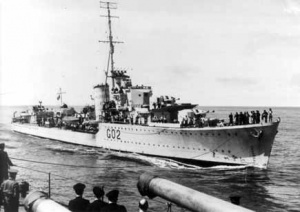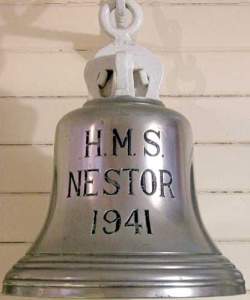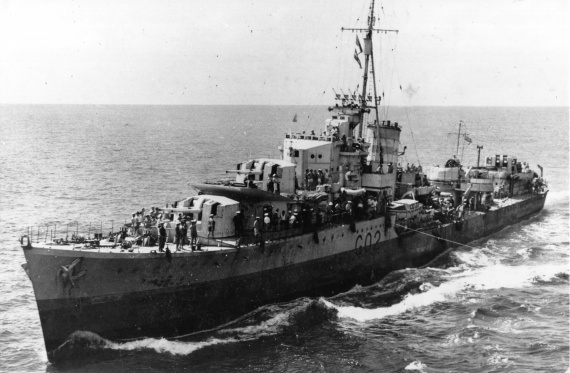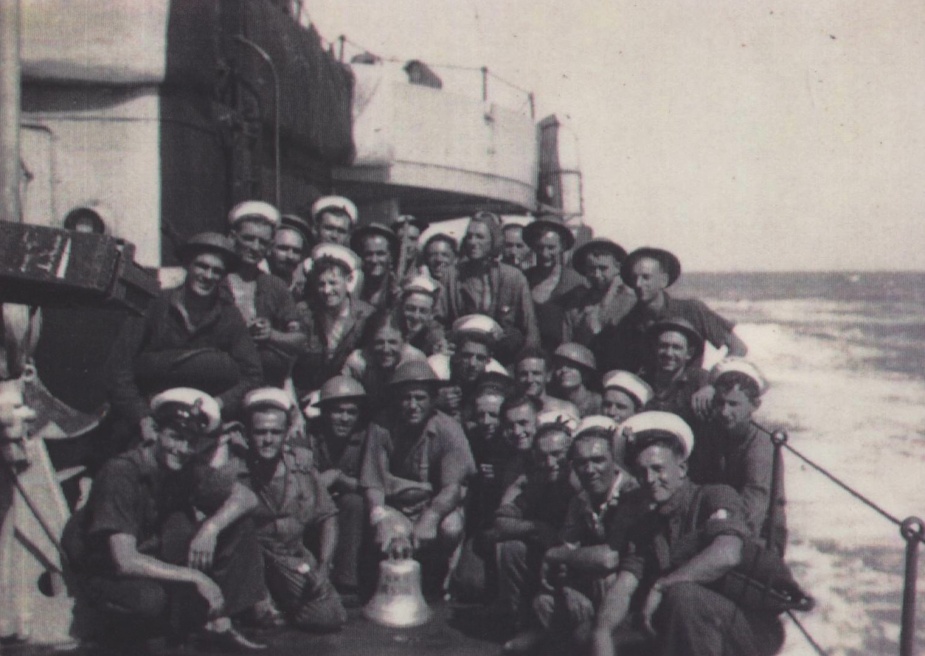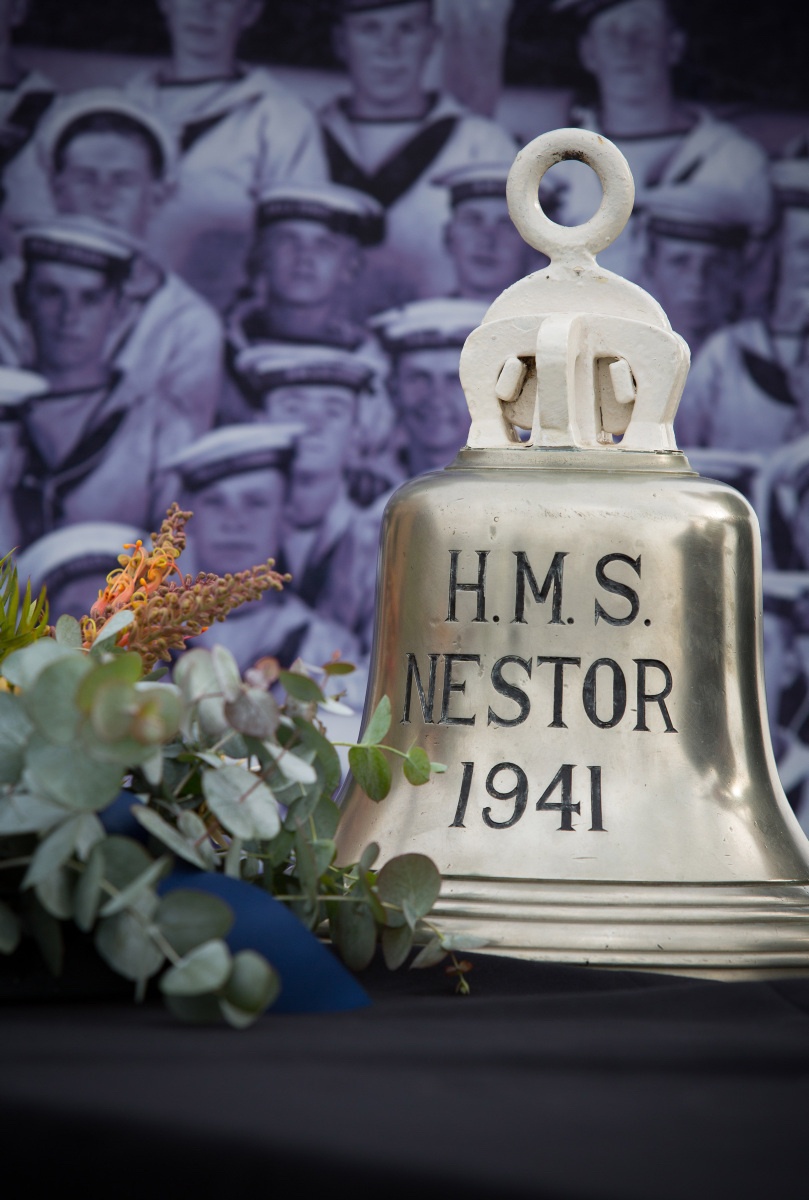HMAS Nestor
| Class |
N Class |
|---|---|
| Type |
Destroyer |
| Pennant |
G02 |
| Builder |
Fairfield Shipbuilding & Engineering Co Ltd, Govan, Glasgow |
| Commissioned |
3 February 1941 |
| Decommissioned |
16 June 1942 |
| Fate |
Lost in action on 16 June 1942 |
| Dimensions & Displacement | |
| Displacement |
|
| Length | 356 feet 6 inches |
| Beam | 35 feet 6 inches |
| Draught | 16 feet 4 inches |
| Performance | |
| Speed | 36 knots |
| Complement | |
| Crew | 249 |
| Propulsion | |
| Machinery | 2 Parsons geared turbines, 2 shafts |
| Horsepower | 40,000 |
| Armament | |
| Guns |
|
| Torpedoes | 10 x 21-inch torpedo tubes (2 pentad mounts) |
| Other Armament |
|
| Awards | |
| Battle Honours | |
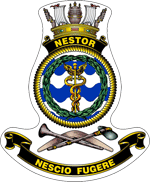
HMAS Nestor was one of eight N Class destroyers laid down in British shipyards during 1939 to the order of the Royal Navy. Five (Napier, Nestor, Nepal, Nizam and Norman (I)) were transferred to the Royal Australian Navy, two to the Royal Netherlands Navy and one to the Polish Navy.
Nestor was commissioned on the Clyde on 3 February 1941 under the command of Commander George Stewart, RAN. She joined the Home Fleet based at Scapa Flow and spent the first months of service escorting North Atlantic convoys, on patrol and screening the fleet capital ships at sea.
Commander Stewart was replaced as Commanding Officer in early May 1941 and Commander Alvord Rosenthal, RAN became the new Commanding Officer. In late May Nestor was a unit of the force which hunted and sank the German battleship Bismark, although having been diverted to Iceland to refuel she was not with the force when the Bismark was eventually sunk on 27 May 1941.
In July 1941 Nestor entered the Mediterranean for the first time when she operated as one of the escorts for the passage of important Malta convoys (Operation SUSTENANCE). In August she saw further Mediterranean service before proceeding on escort duties to the South Atlantic. In October 1941 she returned to England for repairs and refit.
Escort duties were resumed on 5 December 1941 when she sailed from Devonport to rendezvous with a Gibraltar bound convoy. On 15 December, off Cape St Vincent, she sighted the German submarine U-127 on the surface at a distance of about seven miles. Nestor opened fire with her main armament, forcing the U-boat to dive, and after gaining contact made a successful attack with depth charge. She was later officially credited with the destruction of U-127 which was lost with all hands.
On Christmas Eve 1941 Nestor returned to Malta. Two days later she proceeded as one of the escorts of a convoy bound for Alexandria and on 30 December, sailed from that port on the screen of the heavy ships for the bombardment of Bardia in Libya, prior to its capture by the British 8th Army.
In January 1942 Nestor left the Mediterranean theatre to support operations to reinforce Malaya. On reaching Aden, she was ordered to join the escort of the aircraft carrier HMS Indomitable, engaged on ferrying aircraft to the Malayan/Java theatre. The operation successfully concluded, the carrier and her escort proceeded to Port Sudan to load a second flight of planes. Too late to land them in Malaya (Singapore had fallen), they were flown off some 100 miles off Colombo in time to take part in the defence of that port against the first Japanese air attack. Parting from Indomitable, Nestor proceeded to Trincomalee and after docking at Colombo joined the Eastern Fleet, then being reformed under Admiral Somerville.
In late March and early April Nestor was engaged on patrol and escort duties in the Indian Ocean and on the screen of the Fleet. Following a visit to the temporary base of the Eastern Fleet at Kilindini (East Africa) she proceeded on an exercise cruise to Zanzibar and in June returned to the Mediterranean.
At Haifa in June 1942, in company with HMAS Norman (I), she was joined by HMA Ships Napier (Captain SHT Arliss DSO RN) and Nizam, forming the 7th Destroyer Flotilla for Operation VIGOROUS, the passage of an east to west Malta convoy. The total covering force comprised eight cruisers and twenty-six destroyers supported by corvettes and nine submarines.
Enemy air attacks carried out almost exclusively by land based aircraft began almost as soon as the convoy left Alexandria. Early attacks were concentrated on the cruisers and the eleven ships of the convoy but later the destroyers became the principal targets.
On the afternoon of 15 June a signal was received intimating that a second convoy had succeeded in reaching Malta from the west (Operation HARPOON), but in view of the strength of enemy air attack and the presence of the Italian fleet, it was finally decided to break off the westward passage and return to Alexandria.
At about 1800 on 15 June 1942, when the convoy was off the south west corner of Crete (33°36´N, 24°30´E), Nestor was straddled by a stick of heavy bombs which caused serious damage to her No.1 boiler room and killed four of her personnel (Stoker Petty Officer Jack Bulmer, Leading Stoker Matthew Burns, Leading Stoker Campbell Hill and Stoker Leslie Blight). She was taken in tow by HMS Javelin but she continued to take on water and at about 0530 the next morning (16 June) with the destroyer going down by the bow, permission was requested to scuttle. After the crew had been transferred to Javelin she was sunk at about 07:00 by depth charge.
Other losses in the attempt to reach Malta from the east included one cruiser, two destroyers, and two merchant ships sunk. Three cruisers, one destroyer and one corvette were damaged.
Further Reading
N-Class: The Story of HMA Ships Napier, Nizam, Nestor, Norman & Nepal by LJ Lind and MA Payne - republished by The Naval Historical Society of Australia, Garden Island, 2019. Available at https://www.navyhistory.org.au/product-category/books/.

